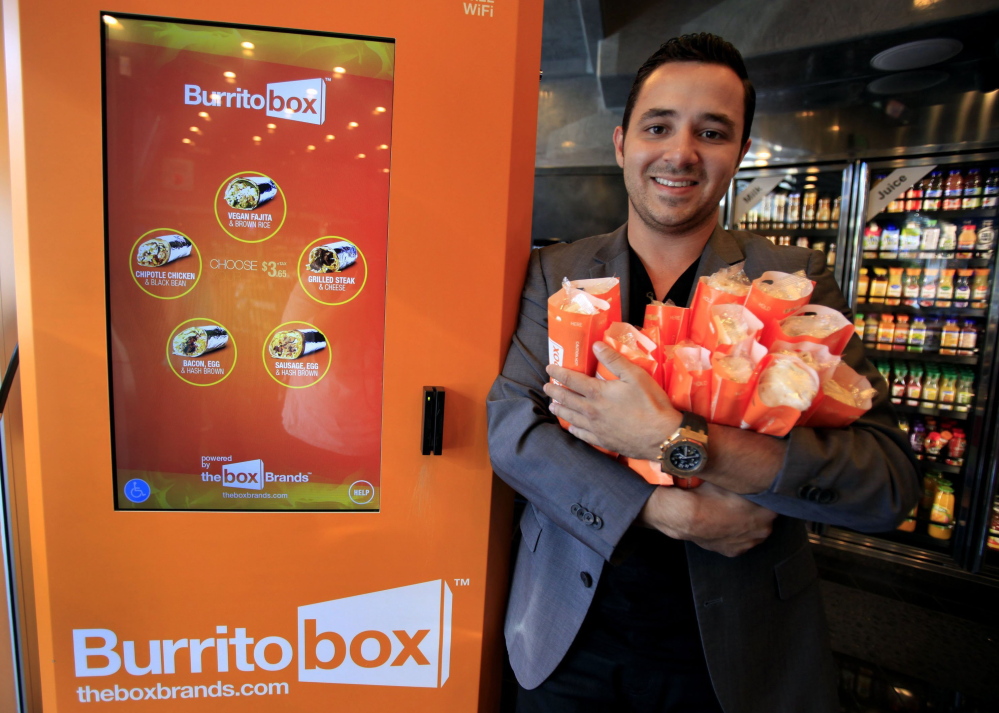LOS ANGELES — At Hollywood and Highland Center, mere steps from Hollywood Boulevard’s souvenir-hawking dives, tourists can drop up to $1,000 on fine caviar.
But they aren’t pampered with white-glove service. Tins of the delicacy are dispensed at the tap of a button – from a vending machine.
After decades of dispensing junk food, vending machines are putting on airs.
High-tech versions are popping up at gas stations and shopping malls, peddling edibles more commonly found at restaurants or specialty stores. Some offer Wi-Fi and touch screens that entertain shoppers while they wait. Many accept credit or debit cards, and a few even sell very expensive items such as jewelry.
“There is a lot of innovation happening in vending machines,” said Omar Khedr, industry research analyst at IBISWorld. “It’s occurring in niche markets like organic foods, propelled forward by access to new technology and convenience.”
Sprinkles Cupcakes is installing its “Cupcake ATM” at all 16 bakeries around the country. L’Oreal tested a vending machine in New York during the holidays that scanned a shopper’s outfit and recommended complementary makeup. San Francisco startup Momentum Machines is making a device that cooks up customized burgers with no help from human hands.
Such vending extravagance is driven by consumers with increasingly picky tastes who still want convenience on the go. The boom in mobile and Web-based shopping also has trained customers to browse and buy with no help from salespeople or waiters.
“It’s a case of technological innovation at an affordable price,” said Christopher Salyers, author of “Vending Machines: Coined Consumerism.” “The Internet has only proliferated this worldview of pay-and-click consumers.”
Long before McDonald’s, coin-operated vending machines served pies and sandwiches to armies of harried workers. But the U.S. has since fallen behind Europe and Asia, where futuristic machines offer a vast array of goods including gold bars, eggs and live beetles. In Japan, automated kiosks sell heads of lettuce after growing them under artificial lighting.
Innovations are now driving a renaissance in U.S. self-serve kiosks.
After five straight years of decline, revenue for the U.S. vending machine industry is projected to rise and hit $7.7 billion in 2019, up nearly 7 percent from this year, according to an IBISWorld report. Experts say 2014 marks the comeback of the sector after years squeezed by budget-conscious shoppers who opted for value over vending convenience.
Denis Koci said he spent five years developing the technology for the Burritobox, which offers warm burritos on demand. His Los Angeles company, the Box Brands, rolled out six machines this year and in August will start franchising nationally in places such as colleges, Koci said.
Diners can pick between options such as hand-rolled vegan fajita burritos for $3.65 and add sides such as guacamole and sour cream. Soon the boxes will toast the burritos and also offer warmed chips with salsa. The products are heated inside to 195 degrees before popping out.
Koci said he was inspired by the “Star Trek” television series, on which a machine called the replicator made meals on demand.
Within six months, the company plans to roll out Pizzaboxes that bake pies to 800 degrees.
“The goal is to do what they do in fast-food restaurants inside a machine,” Koci said.
But to succeed, companies will have to overcome doubts about the quality of vending machine fare, analysts said.
Food companies are seeing opportunities to get inside schools that are getting rid of chip-and-soda machines and replacing them with more-healthful options.
Jamba Juice has installed JambaGo machines in hundreds of schools. Last year, the Emeryville, Calif., company put about 1,400 machines in places like Target and has an additional 1,000 planned this year.
“There is a huge opportunity to offer healthier alternatives to kids,” said James White, Jamba Juice’s chief executive. “It’s about making the brand more accessible.”
Some see machines as a way to turn their stores into 24-hour operations.
Sprinkles Cupcakes in Beverly Hills plans to install its Cupcake ATM at all of its bakeries within a year, up from the six currently in operation, said Nicole Schwartz, vice president of marketing.
Each ATM holds up to 760 cupcakes; some machines can sell four at a time from a range of flavors, including one for dogs.
One kiosk sells an average of 1,000 cupcakes a day – up to 50 percent of total daily sales at each bakery.
Send questions/comments to the editors.



Success. Please wait for the page to reload. If the page does not reload within 5 seconds, please refresh the page.
Enter your email and password to access comments.
Hi, to comment on stories you must . This profile is in addition to your subscription and website login.
Already have a commenting profile? .
Invalid username/password.
Please check your email to confirm and complete your registration.
Only subscribers are eligible to post comments. Please subscribe or login first for digital access. Here’s why.
Use the form below to reset your password. When you've submitted your account email, we will send an email with a reset code.